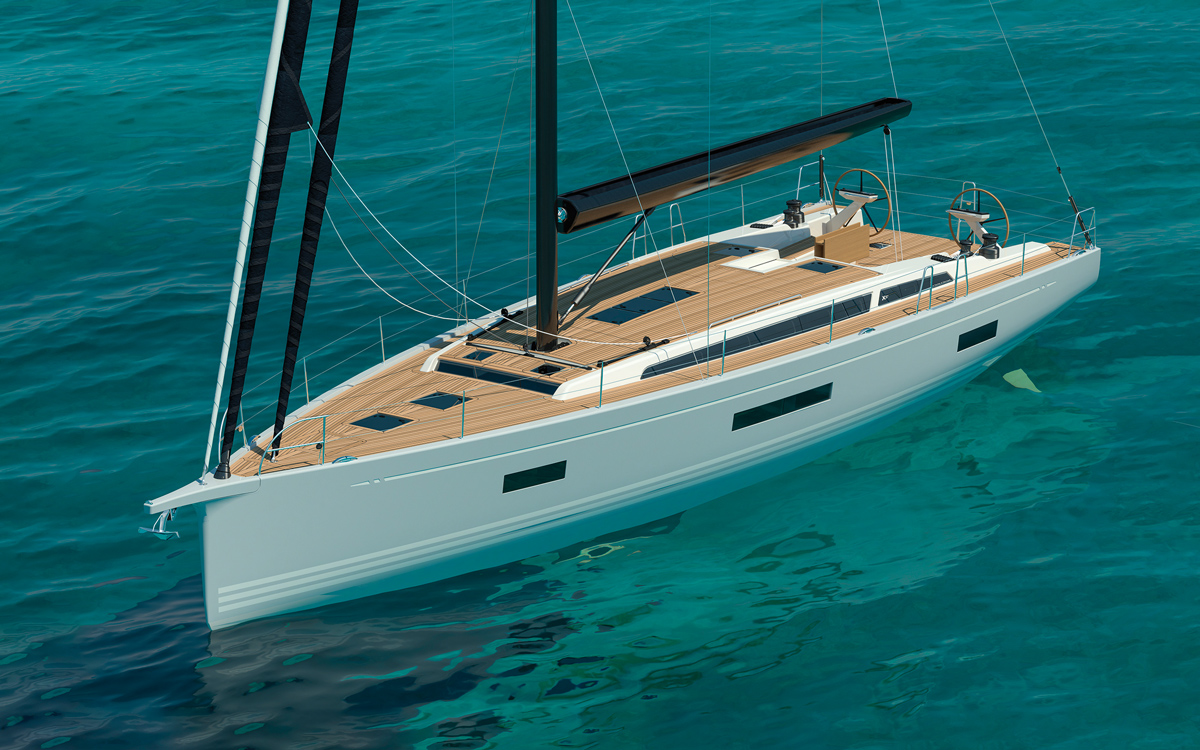This new brand is the result of a Swedish owner seeking a very light displacement boat with performance (and some design aspects) akin to that of the ClubSwan 50, but with easy handling for day sailing and occasional overnighting with family and friends in the Stockholm archipelago.
Mats Bergryd approached father and son team Håken and Oscar Södergren for the design. “The commission from Mats was to make a competitive 50ft racer suitable for our archipelago with its rather shallow and narrow waters,” says Håken. “A boat that can be easily handled by a small crew for ordinary sailing, yet fully able to sock it to hot competition in the Gotland Round Race and other events.”
Overall beam is narrow, but maximum beam is carried right aft with the objective of producing an easily driven hull for sailing within the confined waters of the archipelago. Visually the bow is intended to form an extension of the sheerline, while broad forward sections hint at more form stability than the slender hull suggests.
A hydraulic lifting keel, which operates at the push of a button, reduces the 3.5m draught to a more manageable 2.0m. The spars and keel fin are built by Marstrom Composites, the latter being of solid carbon and carrying a 3.5 tonne bulb to give a hefty 45% ballast ratio.
Article continues below…
X56 first look: New model combines powerful hull with spacious accommodation
The ethos of this range, which appeals to those looking for a state-of-the-art performance cruiser, is now firmly established. “Around…
Grand Soleil 44 Performance: New cruiser-racer to expand Italian yard’s range
With 4,500 yachts built to date, this Italian brand has recently increased capacity to 200 builds a year across its…
The sail plan is intended to enable a small sail inventory to give good performance across a wide range of conditions. The rig is mounted well aft in the boat – it’s actually behind the keel. This creates space for a self-tacking jib of a decent size, while a square top mainsail helps maximise total sail area. For light airs there’s an option of a 110% headsail, while a self-tacking J3 can be set from a removable inner forestay in stronger winds.
Given the rig’s centre of effort is further aft than a conventional sail plan, the twin rudders are deeper and larger than usual. “They have a forgiving profile to maintain laminar flow and a lot of lift will be supplied by the rudder blades,” says Södergren. Benches each side of the forward part of the cockpit are a nod to the boat’s dual-purpose concept, as is the thin 3.5mm teak deck.
The Shogun 50 is built by Rosättra Båtvarv, a long established yard north of Stockholm that’s better known for its range of semi-custom 34-43ft Linjett fast cruisers.
The construction is of carbon fibre and vacuum epoxy on a sandwich core, using Divinycell panels that are automatically cut to exactly the right size and shape.
Interior layouts are down to individual clients, with the first Shogun 50 benefitting from two distinct zones below decks. A large working area by the companionway is big enough to pack spinnakers and houses a settee to starboard and navigation station to port.
Forward of this, the heads/shower is on one side of the lifting keel case and the galley on the other. The latter leads to a larger saloon, with seating around a U-shaped table. This area is designed so that it can also be converted to a master cabin. In addition, there are two smaller double aft cabins.
Furniture is made of carbon fibre sandwich. “Our focus is to build it as light as possible, with sandwich material of carbon and epoxy, plus wood veneer,” says Daniel Gustafsson of Rosättra. He says that, despite the requirement to minimise weight, the quality of the work done by the yard’s shipwrights will be very evident.
A smaller fixed keel model, the Shogun 42.6, has been announced, with the first boat due to be launched later this year.
Specification
LOA: 15.24m (50ft 6in)
LWL: 14.20m (46ft 7in)
Beam: 3.88m (12ft 9in)
Draught: 2.00-3.50m (6ft 7in-11ft 6in)
Displacement: 7,900kg (17,400lb)
Base price: SEK15.4 million (approx £1,230,000)
First published in the July 2020 edition of Yachting World.





